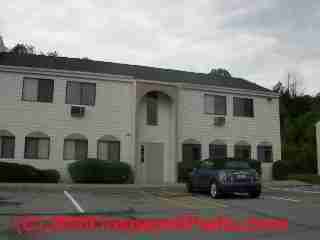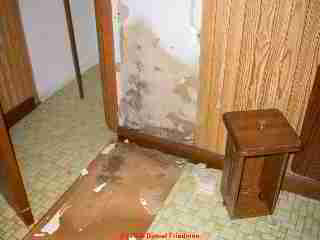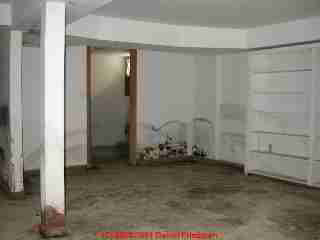 Guide to Hidden Mold in Rental Homes, Apartments, Offices
Guide to Hidden Mold in Rental Homes, Apartments, Offices
- POST a QUESTION or COMMENT about hidden mold problems in rental apartments
This article describes the steps that a tenant in a rental apartment or rental home can take to look for and test for hidden mold contamination, we discuss when such testing is appropriate, and we make suggestions on how to inform building management of a mold problem, what to expect the rental property managers to do if they are going to address a mold problem properly, and what the rental apartment tenant needs to watch out for during a mold investigation and mold remediation of their home.
An easy-to-print PDF version of this article is here.
InspectAPedia tolerates no conflicts of interest. We have no relationship with advertisers, products, or services discussed at this website.
- Daniel Friedman, Publisher/Editor/Author - See WHO ARE WE?
A Guide to Possible Hidden Mold in Rental Apartments, Houses, Offices
 The mold that you *see* may not by any means be the whole problem, or even much of the problem; various species could be
in building cavities and in the HVAC system.
The mold that you *see* may not by any means be the whole problem, or even much of the problem; various species could be
in building cavities and in the HVAC system.
Too often we find that "black mold" on building surfaces has received attention but hard-to-see Penicillium sp. or Aspergillus sp. (for example) remain in large reservoirs on building surfaces or in insulation.
Magic bullets: Also, "bleaching mold" or "fogging" or "encapsulating" mold is never a successful remedy for a moldy building.
The places where mold is growing must be found, moldy material removed, exposed surfaces cleaned, and the causes of mold growth corrected.
If the area of mold growth is large (more than 30 sq ft) the work needs to proceed with special procedures to avoid spreading moldy dusty debris around.
Tenant-identified possible mold reservoirs
The tenant or building maintenance staff may have already identified apparent mold reservoirs or sources, and of course there could be other sources from other leaks or problems they haven't discovered:
Roof leaks - can have leaked into ceilings and walls; depending on what building materials used, they could be moldy with problem molds.
HVAC systems - If there is a common A/C duct system which has become mold contaminated, no amount of cleaning in your immediate apartment would be sufficient since it is possible that the whole system needs to be cleaned, or possibly some duct sections replaced, and the cause corrected. Also it is common for A/C condensate or water from a chiller system to leak; water could have leaked into your closet ceiling and walls, also creating a problem mold reservoir.
Building insulation - often building insulation has become mold contaminated but looks "clean" to the naked eye. Few mold inspectors test this material, yet it is often discovered to be the principal problem mold reservoir in some building areas.
Very often when I visit a site I find other leaks and mold sources that need to be addressed, so I wouldn't assume these are the full extent of what needs attention.
Question:
Is it safe to have plastic flooring over a wood floor over a concrete slab foundation, regardless of anything else, or is the plastic flooring a moisture trap that would probably cause a mold buildup even without a flooded foundation for two months? Has anyone looked at this? At all? I looked at the Building Code of Canada, hoping it would helpfully say "Don't ever do this!!!!!" and it doesn't, alas.
My landlord put the plastic layer down about 6-7 years ago. In the bathroom (currently gutted) there was wood over concrete, and ceramic and vinyl over the wood, and the wood had rotted in multiple locations. In the kitchen there is linoleum/vinyl over wood over concrete.
The floor under the sink is rotted and the boards elsewhere are warped, but the city hasn't ordered the landlord to fix it. I have no idea what's going on under the plastic in the main area because I don't know how to have a look without causing damage. I'm looking for ammunition to get the floors in the main room/kitchen officially looked at.
I can't afford to pay a consultant (on disability in Montreal) but was hoping that you could point me to something that might help. I didn't see anything on Inspectapedia but maybe don't know what to look for. If you want more details I can send you them.
Thank you for all the information you do have on mold. It's been very helpful. - A.C., Montreal, 11/21/2013
Reply:
I agree that this topic has not been pinned down, as I will explain in a moment. A competent onsite inspection by an expert usually finds additional clues that would permit a more accurate, complete, and authoritative answer than we can give by email alone. You will find additional depth and detail in articles at our website.
That said I offer these comments: I have observed that trapped moisture within a floor structure indeed will ultimately rot the materials. All mold is everywhere all the time - it's the concentration that varies.
So all we need is a few mold spores of wood rotting fungus to have been present when a floor, perhaps dry at the time, was enclosed and sealed such that later water entry from below initiates mold growth and rot. But still, I have inspected a number of floor structures built on concrete that were sealed from above and later disassembled to show no rot damage.
The key variable, as you pose, is leaks and water entry. In short, if the building does not leak from above or up from below through the foundation or slab, the enclosed floor cavity, say sleepers on concrete, topped with perhaps subflooring, finish flooring, and tile or laminate or vinyl sheet flooring, survives quite well.
If the same floor structure cavity is wet from any source and is not opened and dried promptly mold growth and later rot can be expected to develop.
I believe that the codes are silent on this point because of the variables involved and the anticipation that good building design and proper maintenance is not supposed to tolerate water entry up through the floor of an occupied space. In other words, build and maintain your building to keep water out.
That approach is probably more cost-effective and easier to specify than to try to make every single indoor component able to withstand flooding. To be clear, we could just as well say don't ever enclose a wall or ceiling, because water can get in and cause trouble.
But we do enclose them. (And water does leak in and cause trouble.) Moving on to the specific case you describe, re: "The floor under the sink is rotted and the boards elsewhere are warped, but the city hasn't ordered the landlord to fix it." suggests to me that
- there are building leaks that need to be corrected, and that are causing costly damage to the building
- If typical building materials used such as drywall & fiberglass insulation are being wet, there is a reasonable risk of problematic mold contamination indoors too.
Please take a look at the article series I've written specifically for people in your situation, beginning
at RENTERS & TENANTS ADVICE for UNSAFE or UNHEALTHY HOME and let me know if questions remain after you've seen that material.
...
Reader Comments, Questions & Answers About The Article Above
Below you will find questions and answers previously posted on this page at its page bottom reader comment box.
Reader Q&A - also see RECOMMENDED ARTICLES & FAQs
On 2017-04-13 by (mod) -
Bobbie
The dose makes the poison. Two spores of highly toxic mold can float in from a window. What's needed is a competent onsite inspection to identify a substantial harmful mold reservoir and its cause and the cleanup needed. "Tests" for mold, alone are unreliable and are not diagnostic nor presecriptive.
On 2017-04-13 by bobbie
I have several types of proven toxic mold in my apartment In court judge did not address the problem. Management just covered everything over It's all coming back and new mold is growing. Owners still refuse to address the problem. What can I do?
On 2012-09-01 by Elisa in Atlanta
After experiencing constant congestion, joint pain,headaches, burning and runny eyes, and even a trip to the ER due to a severe asthma attack 3 months after moving into my new apartment, I decided to check the air filter in my HVAC system and discovered large amounts of dry black mold growing on the drywall, cement floor, and plastic pipes behind and around the water heater and HVAC system in the mechanical closet of my apartment.
I immediately notified the propety manager who initially wanted maintenance to clean the surface. I said "NO WAY, don't touch it" and insisted on professional mold removal specialists to fix the problem, and her regional mgr agreed. I have been out of my apt for a week while the mold is hopefully removed. However, I am concerned that the removal methods being performed are inadequate.
Apparently, they replaced the drywall and the water heater, spayed behind the affected area, used an air scrubber, and will be cleaning the vents. After which I am told an air quality tester will test my apt and I can move back in on the same day, which I think is odd.
Are the test results instant? I have gone by and looked in the window and have never seen any containment plastic. I asked how they intend to clean the rest of my apartment since spores have likely spread ecerywhere due to the location of the mold in and around the HVAC system. Shoukd they also replace the HVAC system, including the ducts, vents and the outside Unit?
Should my whole apartment be repainted? What about my couch and mattress? I was told they will pay to have my clothes and bed comforter dry cleaned but is that enough? I'm very concerned since my health has already been compromised. Although my headaches and burning, watery eyes have stopped since now that I am out of my apartment, I am still terribly congested and have difficulty breathing at times. I would appreciate your advice, Thanks in advance.
...
Continue reading at MOLD ACTION ADVICE for RENTERS or select a topic from the closely-related articles below, or see the complete ARTICLE INDEX.
Or see
Rental Unit & Tenants Guide to Mold & Indoor Environmental Hazards
- RENTERS & TENANTS ADVICE for UNSAFE or UNHEALTHY HOME
- HEALTH DEPARTMENT HELP for RENTERS
- HIDDEN MOLD RISKS for RENTERS
- HOUSING, EMERGENCY & TEMPORARY
- LEGAL AID ATTORNEY HELP SOURCES
- MOLD ACTION ADVICE for RENTERS
- MOLD CONTAMINATION CAUSES
- MOLD HEALTH RISKS for TENANTS
- MOLD SAFETY ADVICE for TENANTS
- MOLD ADVICE for BUILDING MANAGERS
- TENANT HELP for MOLDY RENTAL
- TENANT LANDLORD MOLD DISPUTE
- UNSAFE ENVIRONMENT, CAN'T LEAVE - what if you have to continue to live in a moldy apartment or rental home?
- MOLD: A COMPLETE GUIDE - home
- MOLD / ENVIRONMENTAL EXPERT, HIRE ? - figure out when to hire someone
Suggested citation for this web page
HIDDEN MOLD RISKS for RENTERS at InspectApedia.com - online encyclopedia of building & environmental inspection, testing, diagnosis, repair, & problem prevention advice.
Or see this
INDEX to RELATED ARTICLES: ARTICLE INDEX to BUILDING ENVIRONMENT
Or use the SEARCH BOX found below to Ask a Question or Search InspectApedia
Or see
INDEX to RELATED ARTICLES: ARTICLE INDEX to MOLD CONTAMINATION & REMEDIATION
Or use the SEARCH BOX found below to Ask a Question or Search InspectApedia
Ask a Question or Search InspectApedia
Try the search box just below, or if you prefer, post a question or comment in the Comments box below and we will respond promptly.
Search the InspectApedia website
Note: appearance of your Comment below may be delayed: if your comment contains an image, photograph, web link, or text that looks to the software as if it might be a web link, your posting will appear after it has been approved by a moderator. Apologies for the delay.
Only one image can be added per comment but you can post as many comments, and therefore images, as you like.
You will not receive a notification when a response to your question has been posted.
Please bookmark this page to make it easy for you to check back for our response.
IF above you see "Comment Form is loading comments..." then COMMENT BOX - countable.ca / bawkbox.com IS NOT WORKING.
In any case you are welcome to send an email directly to us at InspectApedia.com at editor@inspectApedia.com
We'll reply to you directly. Please help us help you by noting, in your email, the URL of the InspectApedia page where you wanted to comment.
Citations & References
In addition to any citations in the article above, a full list is available on request.
- In addition to citations & references found in this article, see the research citations given at the end of the related articles found at our suggested
CONTINUE READING or RECOMMENDED ARTICLES.
- Carson, Dunlop & Associates Ltd., 120 Carlton Street Suite 407, Toronto ON M5A 4K2. Tel: (416) 964-9415 1-800-268-7070 Email: info@carsondunlop.com. Alan Carson is a past president of ASHI, the American Society of Home Inspectors.
Thanks to Alan Carson and Bob Dunlop, for permission for InspectAPedia to use text excerpts from The HOME REFERENCE BOOK - the Encyclopedia of Homes and to use illustrations from The ILLUSTRATED HOME .
Carson Dunlop Associates provides extensive home inspection education and report writing material. In gratitude we provide links to tsome Carson Dunlop Associates products and services.


